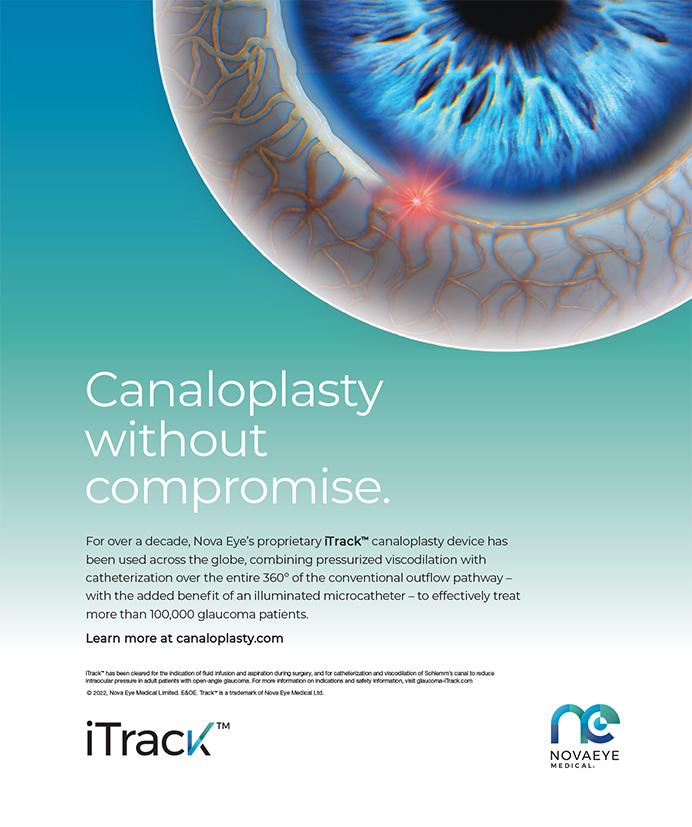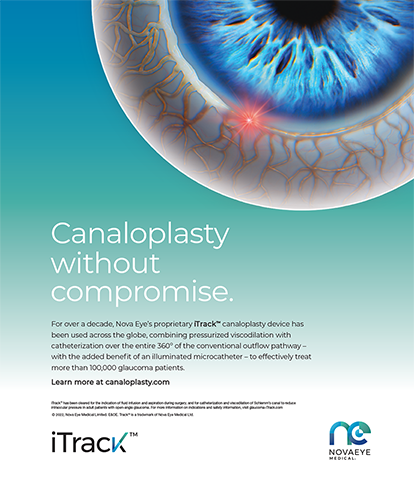By Uday Devgan, MD
A shallow anterior chamber is a challenge during cataract surgery, because it reduces the already tight confines of the anterior segment of the eye. The volume of this working space is often a fraction of a cubic centimeter, with delicate ocular structures just millimeters away. The corneal endothelium and posterior lens capsule are subject to irreparable damage should the fluidic balance destabilize the anterior chamber. Techniques to deepen the anterior chamber during cataract surgery can provide a wider margin of safety and help to ensure excellent visual outcomes.
PREOPERATIVE EVALUATION
Preoperatively, the surgeon should use the slit-lamp microscope to carefully examine the anterior chamber and measure it via biometry. He or she should pay close attention to the relationship of the anterior chamber to the axial length of the eye. A shallow anterior chamber can be present in small but physiologically normal eyes with short axial lengths as well as in nanophthalmic eyes. For these cases, the Holladay 2 formula is often the best option for IOL power calculations due to the anterior effective lens position.
In pseudoexfoliation (PXF), the zonules that support the lens can become loose, which allows the lens-iris diaphragm to push the iris forward and induce a shallow anterior chamber. Biometry of a PXF eye that shows a normal-tolong axial length but a short anterior chamber signals that the zonules will be particularly weak during cataract surgery.
A shallow anterior chamber can also be the result of a pathologic process such as glaucoma. In narrow-angle glaucoma, the anterior chamber is shallow due to the configuration of the anatomic angle. As a cataract develops, the anterior-posterior dimension of the crystalline lens can increase, further crowding the angle. In these eyes, cataract surgery not only improves vision, but it can also help to treat the glaucoma by opening the angle.
INTRAOPERATIVE MANAGEMENT
With a shallow anterior chamber, performing a capsulorhexis is difficult due to poor maneuverability and lack of flattening of the anterior lens capsule. In most situations, the ophthalmologist can address this problem by injecting a high-viscosity ophthalmic viscosurgical device (OVD) at the time of surgery to create and maintain space. Strongly cohesive OVDs such as Healon GV or viscoadaptive products like Healon5 (both from Abbott Medical Optics Inc., Santa Ana, CA) tend to be the most effective choices. When performing the capsulorhexis, surgeons should take care to avoid distorting the corneal incision or causing it to gape, which can cause the anterior chamber to collapse as the OVD escapes the eye. When the chamber becomes shallow, the anterior lens capsule becomes rounded, and the nucleus may move forward, causing the capsulorhexis to “radialize.” In this situation, it is necessary to refill the anterior chamber with more cohesive viscoelastic prior to completing the capsulorhexis.
In rare instances, the anterior segment will remain excessively shallow. A limited pars plana anterior vitrectomy removes volume from the vitreous cavity and permits the surgeon to deepen the anterior chamber further during the cataract procedure. The technique poses risks to the retina, however, and should therefore be used cautiously.
Nuclear removal should occur within the capsular bag via phaco chop or another nucleofractis technique. Supracapsular approaches such as phaco flip are inadvisable because of the limited space in the anterior segment. Phaco power modulations such as pulse or burst modes can minimize the amount of ultrasound energy delivered to the eye.
During phacoemulsification, the surgeon can raise the bottle height to increase the infusion pressure into the anterior chamber and thereby deepen it. The surgeon can decrease outflow by lowering the flow rate, which can help increase the space in which to work within the anterior segment. The combination of watertight incisions and increased infusion pressure allows for maximum deepening of the anterior chamber via fluidics.
CONCLUSION
By replacing the 4-mm thick cataract with a 1-mm thin IOL, cataract surgery in eyes with shallow anterior chambers can restore normal anterior segment anatomy. Surgeons can achieve successful outcomes in these challenging cases through the appropriate use of OVDs, fluidic settings, and surgical techniques.
Uday Devgan, MD, is in private practice at Devgan Eye Surgery in Beverly Hills, Los Angeles, and Newport Beach, California. He is the chief of ophthalmology at Olive View UCLA Medical Center and an associate clinical professor at the UCLA Jules Stein Eye Institute. He is a consultant to Abbott Medical Optics Inc. Dr. Devgan may be reached at (800) 337-1969; devgan@gmail.com.
By Alan S. Crandall, MD
It is important to correctly diagnose the etiology of a shallow chamber, because the surgical management may vary. The problem can result from a number of causes, including hyperopia in a short eye, a phacomorphic eye with or without loose zonules, nanophthalmos, microphthalmia with a coloboma, and narrow-angle glaucoma with or without peripheral anterior synechiae. A careful preoperative examination is crucial and should include gonioscopy, anterior chamber ultrasound biomicroscopy, and accurate biometry. An evaluation with the Pentacam Comprehensive Eye Scanner (Oculus, Inc., Lynnwood, WA) can also be helpful. In short eyes, the Hoffer Q formula can assist with IOL power calculations, as can the ASCRS Web site (http://iol.ascrs.org).
Here are some tips for improving surgical success in these eyes.
PREPARATION
The surgical game plan must take into account the possibility of change after the case starts. I have several backup strategies in mind and numerous tools on hand that may become necessary. The latter include trypan blue dye to stain the capsule, Malyugin Rings (MicroSurgical Technology, Redmond, WA), iris hooks, the Mackool Cataract Support System (Duckworth & Kent Ltd., Hertfordshire, United Kingdom; distributed in the United States by FCI Ophthalmics, Inc., Marshfield Hills, MA), capsular tension rings, and Ahmed Capsular Tension Segments (Morcher GmbH, Stuttgart, Germany; distributed in the United States by FCI Ophthalmics, Inc.). I also have at the ready a 23-gauge vitrector and a 23-gauge microvitreoretinal blade (Alcon Laboratories, Inc., Fort Worth, TX) and a set of microinstruments designed for intraocular manipulations (ASICO LLC [Westmont, IL] or MicroSurgical Technology).
It is important to have a good understanding of ophthalmic viscosurgical devices (OVDs) and their properties and to choose one that will be appropriate. One should remember the crucial differences between cohesive and dispersive OVDs.
I have not routinely dilated the pupil before cataract extraction for several years, but I do use intracameral lidocaine and epinephrine (both unpreserved and buffered). I find this pharmacologic combination particularly helpful in eyes with a shallow anterior chamber, because pupillary dilation occasionally closes the angle, with a resultant spike in pressure and corneal edema.
BASIC PRINCIPLES
Cataract surgery may proceed without a hitch in an eye with a shallow anterior chamber. If it does not, several principles can be of help. I am careful not to overinflate the eye with an OVD, because doing so can raise the IOP and force the iris into the cataract incisions. Because hydrodissection can be tricky, it is important to proceed slowly in a controlled fashion. These eyes are good candidates for prechopping, because one can break the nucleus into quadrants with no flow in the eye. Although it may seem counterintuitive, it is better to start with a low bottle height to avoid elevating the pressure and forcing the iris into the cataract incisions. I frequently somewhat debulk the central nucleus to make space and protect the cornea, and I use a low-flow technique to remove the nucleus.
If the chamber is shallow due to the lens’ moving forward from loose zonules, it will usually become apparent by the chamber’s deepening with the instillation of an OVD. The surgeon’s choice of phaco technique and adjuncts will then be based on how loose the lens is. The first clue comes with the start of the capsulorhexis. I begin with a sharp cystotome and watch for capsular wrinkling and movement of the lens. As the capsulorhexis progresses, it may become necessary to use the Mackool Cataract Support System or iris hooks to maintain the capsule and aid nuclear removal. I find that viscodissection helps me to place the supporting devices. After cataract removal, the next decision regards the location of the lens implant. If the zonules appear stable, a standard capsular tension ring may be sufficient support. Otherwise, I will consider the Cionni Rings for Sclera Fixation (Morcher GmbH; distributed in the United States by FCI Ophthalmics, Inc.) or the Ahmed Capsular Tension Segment with scleral fixation. If the bag has no support, then one can perform iris fixation or implant an ACIOL.
When there is little or no room for surgery (eg, nanophthalmos or a chronically narrow angle), it may be necessary to create some space by means of a pars plana vitrectomy. I use the new 23-gauge anterior vitrectomy unit on the Infiniti Vision System (Alcon Laboratories, Inc.). The unit has a speed of 2,500 cpm and is therefore safer and easier to use than older models. Abbott Medical Optics Inc. (Santa Ana, CA) and Bausch + Lomb (Rochester, NY) will release similar units soon. I use a 23-gauge microvitreoretinal blade placed 3 mm posterior to the limbus and a dry technique. The goal is to remove just enough vitreous to deepen the chamber adequately to work safely.
After removing the cataract, I perform gonioscopy to check for peripheral anterior synechiae, which can be released manually with micrograspers (ASICO LLC or MicroSurgical Technology) or by viscodissection. The choice of IOL is based on personal preference. I like to keep the cataract incisions as small as possible, so I favor a foldable lens. Often, eyes with shallow anterior chambers are small, so I generally shorten the corneal incision (≤ 2.2 mm) to reduce corneal trauma. Particularly if I performed a vitrectomy, I will place a suture (8–0 Vicryl; Ethicon, Inc., Somerville, NJ) to ensure a strong seal.
Postoperatively, it is critical to manage the IOP and to watch for aqueous misdirection syndrome with high pressure and shallowing of the chamber (malignant glaucoma).
Alan S. Crandall, MD, is a professor, the senior vice chair of ophthalmology and visual sciences, and the director of glaucoma and cataract at the John A. Moran Eye Center of the University of Utah in Salt Lake City. He is a consultant to Alcon Laboratories, Inc.; ASICO LLC; Mastel Precision, Inc.; and MicroSurgical Technology. Dr. Crandall may be reached at (801) 585-3071; alan.crandall@hsc.utah.edu.


